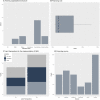Governance models for nature-based solutions: Seventeen cases from Germany
- PMID: 33382443
- PMCID: PMC8249549
- DOI: 10.1007/s13280-020-01412-x
Governance models for nature-based solutions: Seventeen cases from Germany
Abstract
Nature-based solutions (NBS) for mitigating climate change are gaining popularity. The number of NBS is increasing, but research gaps still exist at the governance level. The objectives of this paper are (i) to give an overview of the implemented NBS for flood risk management and mitigation in Germany, (ii) to identify governance models that are applied, and (iii) to explore the differences between these models. The results of a hierarchical clustering procedure and a qualitative analysis show that while no one-size-fits-all governance model exists, polycentricism is an important commonality between the projects. The study concludes by highlighting the need for further research on traditional governance model reconversion and paradigm changes. We expect the findings to identify what has worked in the past, as well as what is important for the implementation of NBS for flood risk management in future projects.
Keywords: Financing instruments; Flood risk mitigation; Institutional structures; Polycentric governance; River Management; Stakeholder participation.
Figures







Similar articles
-
Integrating nature-based solutions in flood risk management plans: A matter of individual beliefs?Sci Total Environ. 2021 Nov 15;795:148896. doi: 10.1016/j.scitotenv.2021.148896. Epub 2021 Jul 6. Sci Total Environ. 2021. PMID: 34252770
-
Effectiveness of small- and large-scale Nature-Based Solutions for flood mitigation: The case of Ayutthaya, Thailand.Sci Total Environ. 2021 Oct 1;789:147725. doi: 10.1016/j.scitotenv.2021.147725. Epub 2021 May 14. Sci Total Environ. 2021. PMID: 34052494
-
The underexposed nature-based solutions: A critical state-of-art review on drought mitigation.J Environ Manage. 2024 Feb 14;352:119903. doi: 10.1016/j.jenvman.2023.119903. Epub 2024 Jan 10. J Environ Manage. 2024. PMID: 38211427 Review.
-
Managing flood risks in the Mekong Delta: How to address emerging challenges under climate change and socioeconomic developments.Ambio. 2018 Oct;47(6):635-649. doi: 10.1007/s13280-017-1009-4. Epub 2018 Feb 24. Ambio. 2018. PMID: 29478182 Free PMC article.
-
Knowledge gaps and future research needs for assessing the non-market benefits of Nature-Based Solutions and Nature-Based Solution-like strategies.Sci Total Environ. 2022 Oct 1;841:156636. doi: 10.1016/j.scitotenv.2022.156636. Epub 2022 Jun 11. Sci Total Environ. 2022. PMID: 35700782 Review.
Cited by
-
Defining depth requirements to conserve fish assemblages from water take in an intermittent river.Sci Rep. 2024 Dec 2;14(1):29863. doi: 10.1038/s41598-024-81339-5. Sci Rep. 2024. PMID: 39623016 Free PMC article.
-
Assessing the role of actors in river restoration: A network perspective.PLoS One. 2024 Apr 16;19(4):e0297745. doi: 10.1371/journal.pone.0297745. eCollection 2024. PLoS One. 2024. PMID: 38625987 Free PMC article.
-
Hydromorphological and socio-cultural assessment of urban rivers to promote nature-based solutions in Jarabacoa, Dominican Republic.Ambio. 2021 Aug;50(8):1414-1430. doi: 10.1007/s13280-021-01565-3. Epub 2021 Jun 1. Ambio. 2021. PMID: 34061346 Free PMC article.
-
Mainstreaming nature-based solutions through five forms of scaling: Case of the Kiiminkijoki River basin, Finland.Ambio. 2024 Feb;53(2):212-226. doi: 10.1007/s13280-023-01942-0. Epub 2023 Oct 24. Ambio. 2024. PMID: 37874454 Free PMC article.
-
Transformative adaptation through nature-based solutions: a comparative case study analysis in China, Italy, and Germany.Reg Environ Change. 2023;23(2):69. doi: 10.1007/s10113-023-02066-7. Epub 2023 May 2. Reg Environ Change. 2023. PMID: 37153538 Free PMC article.
References
-
- Arnouts R, van der Zouwen M, Arts B. Analysing governance modes and shifts — Governance arrangements in Dutch nature policy. Forest Policy and Economics. 2012;16:43–50.
-
- Arnstein SR. A ladder of citizen participation. Journal of the American Planning Association. 1969;35:216–224.
-
- Beniston M. Linking extreme climate events and economic impacts: Examples from the Swiss Alps. Energy Policy. 2007;35:5384–5392.
-
- Brödner R. Reformvorschlag für den Hochwasserschutz in Deutschland. Chemnitz: Technical University of Chemnitz; 2019.
-
- Buijs A, Hansen R, Van der Jagt S, Ambrose-Oji B, Elands B, Lorance Rall E, Mattijssen T, Pauleit S, et al. Mosaic governance for urban green infrastructure: Upscaling active citizenship from a local government perspective. Urban Forestry & Urban Greening. 2019;40:53–62.
Publication types
MeSH terms
Grants and funding
LinkOut - more resources
Full Text Sources
Medical
Research Materials
Miscellaneous

